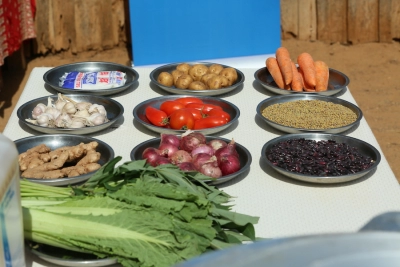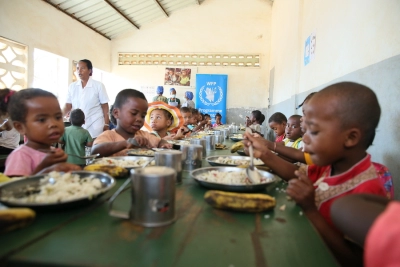By Jerry Randrianilanona, Director of Basic Education and Early Childhood, Ministry of Education in Madagascar

Some of the local foods promoted by the Government for the school meals programme. ©WFP Madagascar
After we joined the School Meals Coalition in 2021, the Madagascar homegrown school feeding programme is making real progress. I remember from 2004 to 2020, our programme was based on centralised food purchases at the Ministry of Education through a public procurement procedure. We encountered problems, including incurring high costs due to transportation and high profit margins set by suppliers, unsatisfactory food safety, service delays, and losses in provisions during transportation. When the supply chain is ineffective, it is the children that suffer the most because some of the food does not reach schools on time.
Our turning point was when we joined the School Meals Coalition. Through learning from other countries, we adopted a new approach to school feeding, which is based on cash transfers to local suppliers. We liked the idea of having funds allocated for school feeding directly transferred from the public treasury to the accounts of each local suppliers. That was a game-changer! This new approach is ensuring we can buy local products at affordable prices. And some may ask: how is that important in these tough economic times? When governments improve school meals governance systems and transparency, they can grow the local economy by increasing the income of small, local producers. With the digitisation of money transfers, governments can also improve tracking of payments, understand how the money is being utilised and its effectiveness in addressing challenges.
This new way of working has empowered the local Community Management Committee (FEFFI), to manage the school cafeteria within the school. The big news for us was their sense of ownership and commitment to support the government to reach more children with more nutritious food. For example, they are ensuring the implementation of basic nutrition principles to ensure that our children eat a mix of fresh foods, in particular vegetables.

Learners at a school in Madagascar enjoy their school lunch meal of rice and mixed vegetables. © WFP Madagascar
We would like to establish a framework for strengthened governance and leadership to scale up and improve the quality of our programme based on local purchases. That way, we can improve the school meal diet, promote healthy eating practices, stimulate innovation to drive our work in community resilience and grow our local economy. When our economy flourishes, we can generate enough revenue to scale up and reach all children with locally sourced fresh and nutritious meals.

